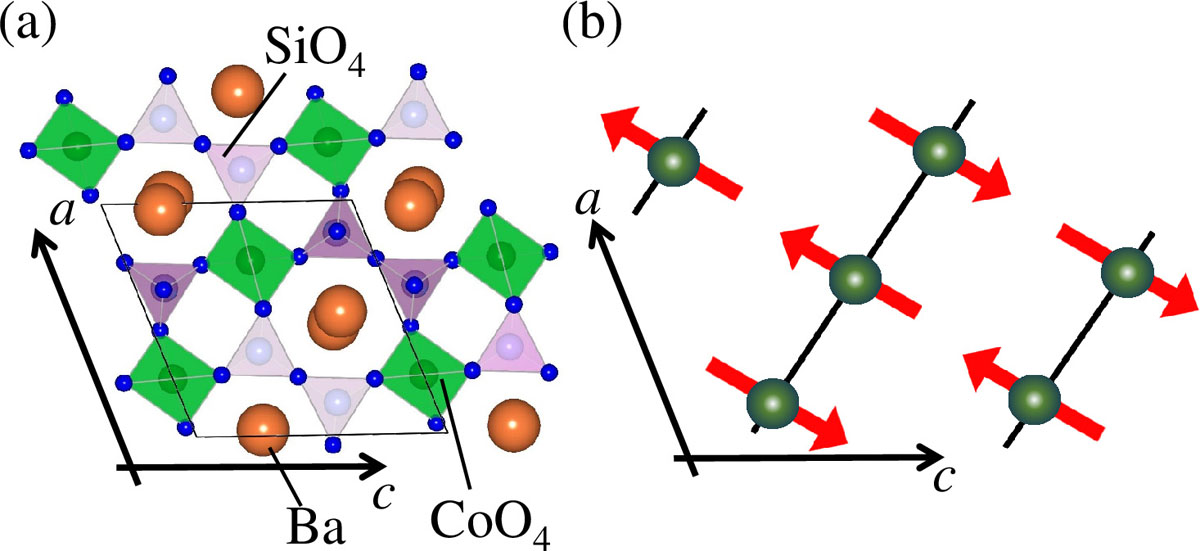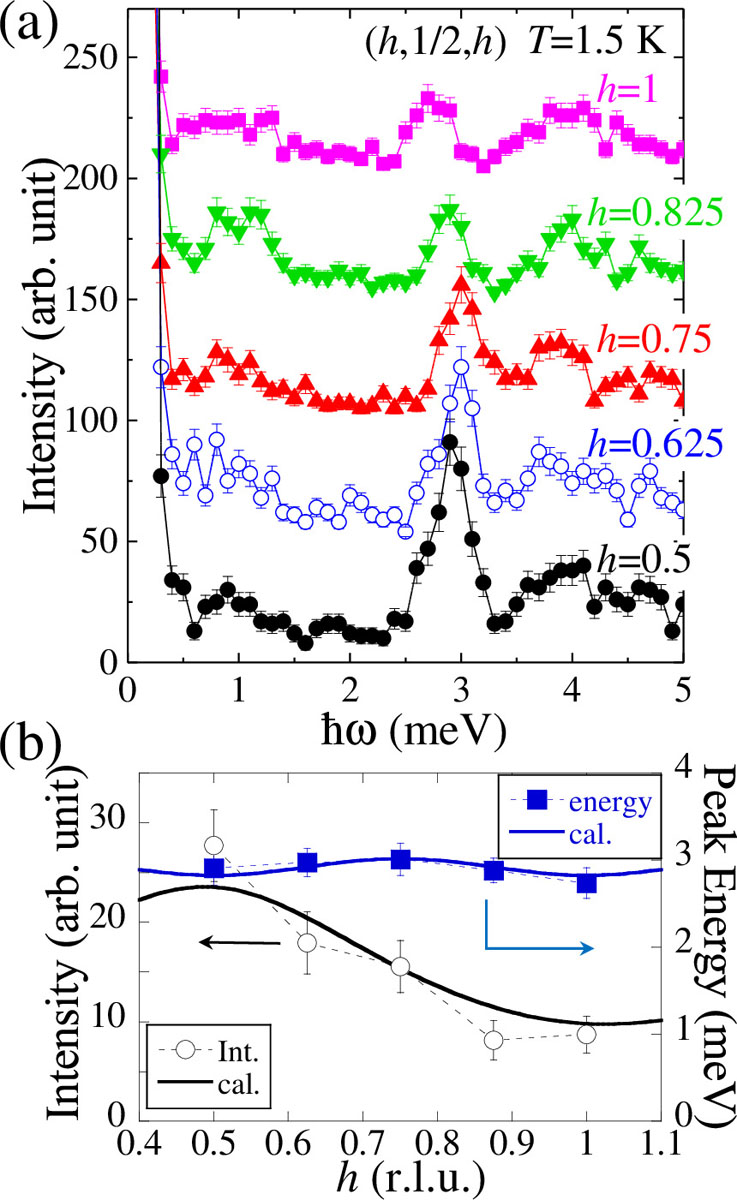Magnetic Structure and Excitation of Quasi One-Dimensional Antiferromagnet Ba2CoSi2O7
Masuda Group
The relationship between magnetism and dielectricity has been extensively studied. In the multiferroics, the ferroelectrics with the cycloidal and proper-screw magnetic structures are explained by the spin-current mechanism and the spin-dependent d–p hybridization mechanism, respectively [1,2]. On the other hand, the multiferroic property has been reported even on a collinear antiferromagnet. One of the maultiferroics with the collinear magnetic structure is an antiferromagnet Ba2CoGe2O7. Ba2CoGe2O7 with the Co-square lattice shows multiferroic properties, and the local electric polarization of CoO4 tetrahedra is explained by the spin-dependent d-p hybridization mechanism [3,4]. In contrast, the anomaly of the dielectric constant in similar material Ba2CoSi2O7 is not observed at the antiferromagnetic transition temperature TN =6 K [5]. Ba2CoSi2O7 has a distorted crystal structure formed by CoO4 and SiO4 networks, as shown in Fig. 1(a), and two kinds of Co-Co bonds exist within the b-plane. In order to clarify the magnetic model of Ba2CoSi2O7, the magnetization and neutron scattering measurements have been performed.
In the neutron powder diffraction measurement using the high-resolution powder diffractometer ECHIDNA installed at OPAL, ANSTO, Australia, the magnetic reflections indexed by the propagation vector (1/2, 1/2, 1/2) was observed below TN = 6 K. By analyzing the powder neutron profile, we found that a collinear antiferromagnetic structure shown in Fig. 1(b) was realized below TN = 6 K. The magnetic moments with the easy axis along the [10-1] form an antiferromagnetic arrangement along [101] and a ferromagnetic arrangement along [10-1]. In the spin-dependent d-p hybridization mechanism, the local electric polarization of the CoO4 tetrahedron is almost zero with the magnetic moment along [10-1]. This is consistent with the dielectric property where the temperature dependence of the dielectric constant has no anomaly at TN = 6 K.
We have also measured the Q-dependencies of the magnetic excitations along the b*, [10-1], and [101] directions at 1.5 K to clarify the magnetic correlation of Ba2CoSi2O7 by using a cold-neutron triple-axis spectrometer (CTAX) installed at HFIR, ORNL, USA. Figure 2(a) shows the constant-Q scan profiles measured at (h, 1/2, h). Figure 2(b) shows the h-dependence of integrated intensities and peak energies obtained by Gaussian fitting of the constant-Q profiles at (h, 1/2, h), which corresponds to the Q-dependence along the [101] direction. The excitation observed at ħw = 2.9 meV is almost dispersionless, but the integrated intensity exhibits a clear modulation along the [101] direction. In the measurements along the b* and [10-1] directions, on the other hand, both the neutron intensity and peak energy show less change. (not shown)
We analyzed the magnetic excitation by using the spin Hamiltonian in order to clarify the magnetic model including the magnetic interaction in Ba2CoSi2O7. To explain the observed magnetic excitation, we consider the one-dimensional antiferromagnet in which the antiferromagnetic chain is along the [101] direction. We performed the calculations of the neutron intensity and the dispersion energy for both the easy-axis and Ising-like antiferromagnet models; two models cannot be distinguished in the classical spin-wave theory. The magnetic dispersion relation shown in Fig. 2(b) is reproduced by the one-dimensional antiferromagnet model, as shown by solid curves.
Our results of the neutron scattering suggest that the Ba2CoSi2O7 is the one-dimensional antiferromagnet with the easy-axis spin anisotropy or the Ising-like spin. On the other hand, Ba2CoGe2O7 with the tetragonal structure is two-dimensional easy-plane antiferromagnet. The neutron results suggest that the crystal structure affects both the magnetic interaction dimensionality and anisotropy in åkermanite-type materials.
References
- [1] T. Kimura, T. Goto, H. Shintani, K. Ishizaka, T. Arima, and Y. Tokura. Nature 426, 55 (2003).
- [2] S. Seki, Y. Onose, and Y. Tokura. Phys. Rev. Lett. 101 067204 (2008).
- [3] H. Murakawa, Y. Onose, S. Miyahara, N. Furukawa, and Y. Tokura. Phys. Rev. Lett. 105, 137202 (2010).
- [4] M. Soda, M. Matsumoto, M. Månsson, S. Ohira-Kawamura, K. Nakajima, R. Shiina, and T. Masuda, Phys. Rev. Lett. 112, 127205 (2014).
- [5] M. Akaki, J. Tozawa, D. Akahoshi, and H. Kuwahara, J. Phys.: Conf. Ser. 150, 042001 (2009).


